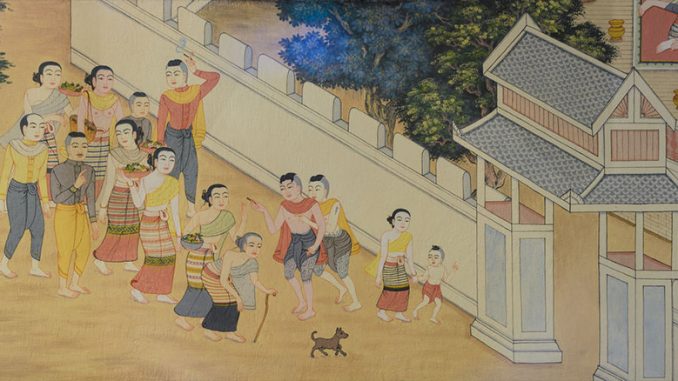
The CIA’s World Factbook describes Thailand as an ethnically homogenous country with Thais comprising 95% of the population. 1 This image hews closely to the official characterization of Thailand that dates back to the late colonial era. As Britain and France encircled Siam (the former name of Thailand until 1939) from all sides, the Siamese elite began referring to the major Tai ethnic groups within its domain of influence as regional members of the Thai ethnic group to which the Siamese belonged. Thus, the Lao of the Khorat Plateau (today about 30% of the population) became the Northeastern Thai, and the Black Lao of the Northern Hills (today about 12% of the population) became the Northern Thai. 2 This Thai project of nationalism proceeded thenceforth, mimicking the European nation states that were threatening its borders. State tools of universal education were paired together with mapmaking, the centralization of Buddhism, and national propaganda to turn peasants into Thai-men, to borrow a phrase from Eugene Weber’s famous monograph on the development of French nationalism. 3How successful has the Thai nationalist project been 120 years on?
I explore this question amongst the Lanna ethnic group of Northern Thailand. The Lanna people of Northern Thailand comprise approximately 8 million people, or 12% of Thailand’s population. 4 More commonly calling themselves by the ethnonym khonmueang, literally “people of the mueang 5”, the group is also referred to as Tai Yuan and Northern Thai. Each of these names have specific historical origins and political implications. Indeed, as Siam was first annexing the territories of the former Lanna Kingdom in 1899, Siamese elites referred to them as Lao. 6
How successful has the incorporation of the Lanna people into the Thai national identity been? To what extent do they see themselves as Thai, and to what extent to these other identities still hold?
One answer to this question can be derived from general attitudes and perceptions of the Lanna. Unlike the negative stereotypes that have often pervaded Thai society about the Isan ethnic group, the Lanna have tended to be painted as a gentle, civilized people. Perhaps it helps that the Lanna do not have co-ethnics living in a border country, like the Isan have in the Lao of neighboring Laos. Perhaps it has to do with the location of the earliest Tai kingdoms within Thailand’s current borders falling in Lanna’s territory. Regardless, Chiangmai is seen as a desirable vacation spot for Bangkokians, who return to the capital with tales of their beautiful, pale skin, soft-spoken tongue, and rich culture.
This essay seeks to go beyond stereotypes, answering the question of the Lanna’s Thai identity by turning to public opinion surveys conducted by the World Values Survey (WVS). In addition, I share results from the Lanna Cultural Project (LCP), which currently involves three surveys I conducted in the North in between 2015 and 2019.
Thai National Identity
I use two questions from WVS, which conducted two waves in Thailand in 2007 and 2013. WVS also asks a question on which language is spoken in the home, which is the best ethnic marker available in the survey, and provides a good, though imperfect, measure of ethnic identity. We can use this measure to examine differences in strength of national identity in Thailand. Figure 1 shows results from the question “How proud are you to be Thai?” by ethnic group. Responses were given on a pre-determined 4-point scale, where 1 signifies “Not at all proud” and 4 “Very Proud”. Most respondents answered either 3 or 4, with the average of all groups above 3.5. The Central Thai (or Siamese)—the dominant group in the country—have the lowest average levels of pride. The Lanna, averaged over the 2007 and 2013 surveys, have the highest level, followed closely by the Isan.
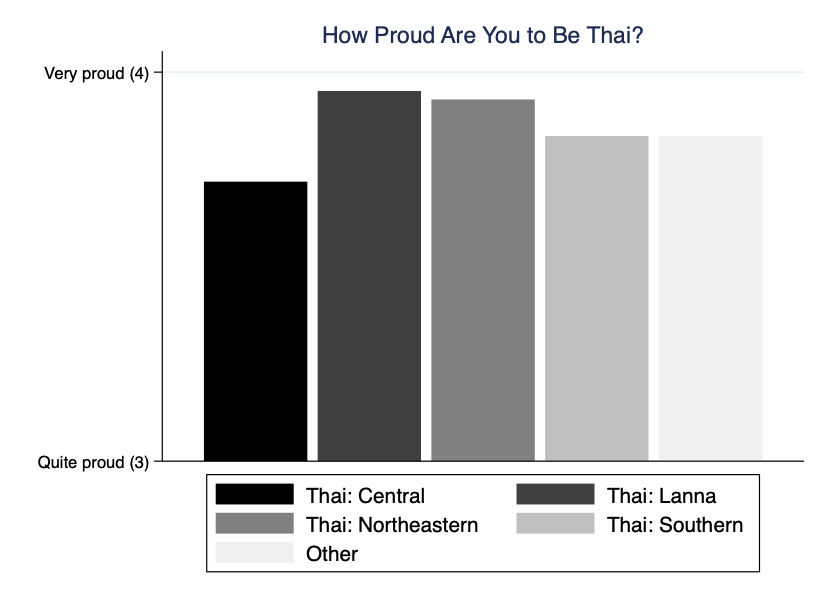
This result is echoed by responses to another question gauging the degree respondents see themselves as a citizen of Thailand, again measured on a 4-point scale. Figure 2 shows that the averages of all groups are somewhere between Agree (3) and Strongly Agree (4). Again, the Lanna have the highest average level on this question.
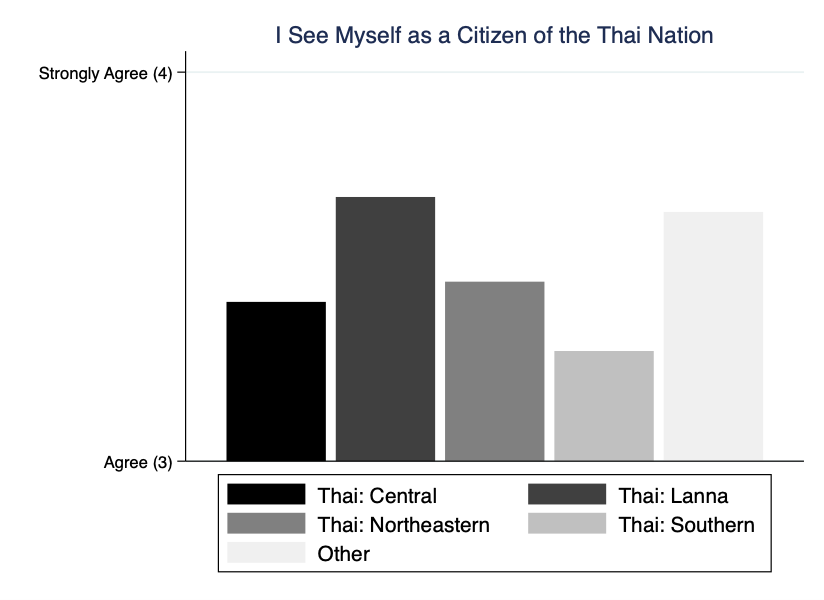
So, should we conclude that the Lanna are the most strongly Thai? What is uncertain in both these questions is the context in which respondents answered. Particularly, who or what is the out-group to which respondents are comparing themselves to? If I don’t have pride in being Thai, what other identity would I have pride in? Similarly, if I am not part of the Thai nation, what other nation would I be a part of? The ethnicity literature has long established that individuals hold numerous identities at the same time, each competing for dominance, both overall and in specific contexts. To illustrate the complexity of simply concluding that the Lanna are the most strongly Thai, I present an additional question from WVS: the degree respondents see themselves as part of their local community. In WVS, this question is asked immediately following the one on seeing oneself as part of the Thai nation. Figure 3 displays these results, revealing that the Lanna come out on top again, suggesting they have both the strongest national and local identities. But how are we to interpret these results? For some, this result is puzzling. Shouldn’t the group with the strongest Thai identity have the weakest local identity? What does this mean?
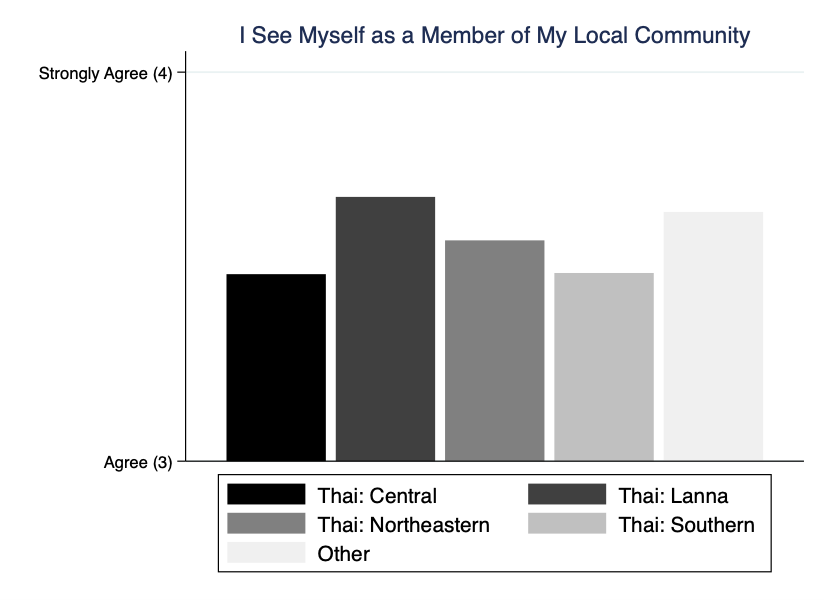
The WVS, which was not designed to analyze questions on national and ethnic identity, are limited in what they can tell us about how ethnic groups in Thailand feel about either the Thai national identity, or the Lanna identity. As such, starting in 2015, I have conducted three surveys that delve into these questions more deeply. First, I re-ask the question “How Proud Are You to Be Thai?”, to tackle the desirability bias and limited scale of the WVS question. First, I ask respondents to compare themselves to the average Thai’s level of pride which we told them was at the middle of the scale. The reason for this was to help respondents feel more comfortable indicating lower relative levels of pride without revealing low absolute levels of pride. In Thailand, there are strong social pressures to exhibit high levels of nationalism and low relative levels do not necessitate low absolute levels, thus minimizing desirability bias. The second adjustment to the question was simply to allow a larger response scale, which I increased from four categories to a 10-point scale. Figure 5 displays the results. Only 11.82% considered themselves the same as the average person in terms of pride in being Thai. Another ~15% consider themselves to have levels of pride lower than the average person. While still low, what these results show is that there is significantly more variation than the WVS results suggest, where only 0.54% of respondents said they were “Not Very Proud” or “Not at All Proud.” The remaining 73% believe themselves to have higher levels of pride in being Thai than the average person, with just 13.69% placing themselves in the top category compared to 95.70% in the WVS survey. Since this was a survey exclusive to the Lanna region of Northern Thailand, I am currently unable to compare this to other ethnic groups. However, what we can see is that there is a lot more variation in strength of Thai identity among the Lanna with the changes I made to the question.
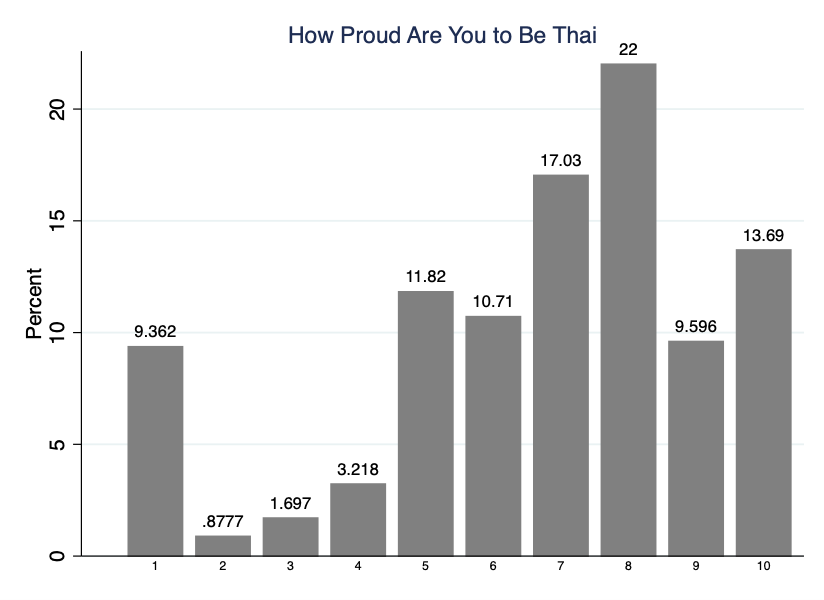
Lanna Identity and Lanna Nationalism
Now, turning to the conundrum of the Lanna having the strongest national local identities in the WVS. A second question in the LCP asks respondents to compare their Thai identity to their regional identities. I presented respondents with six different identities, which they were required to rank from 1 to 6, with 1 indicating they ranked it of the most importance. Table 1 shows the average ranking of each identity. We can see that the Thai identity is ranked the highest on average, with 41.88% of ranking it first and an overall average ranking of 2.37. I gave respondents three options of different ethno-regional identities: Northern, Lanna, and Chiangmai. Together, the three regional identities were ranked first 43.56% of the time. 7 Comparing the three identities, Northern has the second highest average ranking, though both the Lanna and Chiangmai identities were ranked first more frequently. The averages of the three ethno-regional identities were very similar, moreover. This seems to indicate that some individuals may prefer one ethnonym over the other, but on average they are highly substitutable.
Table 1. Rank ordering of identities, Khammueang Speakers
1 2 5 4 5 6 Average
Thai 41.88 19.63 8.39 20.56 9.14 0.41 2.37
Northern 11.01 26.67 38.32 20.44 2.97 0.58 2.79
Lanna 17.47 26.79 24.40 22.36 7.57 1.40 2.80
Chiangmai 15.08 22.54 24.34 27.32 8.44 2.27 2.98
Tai 2.68 2.39 3.79 7.28 51.02 32.85 5.00
Asian 11.88 1.98 0.82 2.04 20.85 62.43 5.05
But is there an association between feelings of pride in being Thai and one’s ranking of the Thai identity with the comparison categories explicitly given? To answer this question, I run a test that is used to measure association between two ordinal variables. 8 The results indicate a very weak level of association. Indeed, 60.00% of Lanna respondents who indicated they had the lowest levels of pride in being Thai, still ranked Thai above any of the regional identities. This compares to just 45.30% of those who indicated they had the highest levels of pride in being Thai. And the relationship is not neatly linear either. In short, there is not a clear relationship between how proud one feels to be Thai and the ranking of their Thai identity, once the Lanna identity is brought into the picture. The best conclusion, therefore, is that individuals are torn between the two identities.
I thus conclude with the results from a final question on the LCP. I asked respondents to explicitly compare their Thai and Lanna identities. This overcomes the problem of three different ethnoregional identities obscuring the comparison. Respondents could indicate that they were “Thai not Lanna”, “More Thai than Lanna”, “Equally Lanna and Thai”, “More Lanna Than Thai”, and finally “Lanna Not Thai”. A similar question has been asked amongst the ethnoregional minorities of the United Kingdom (Welsh, Scottish, and Northern Irish) for many years. As Figure 6 shows, the vast majority of people (72.11%) feel equally Thai and Lanna. There are an equal number of people either side of this middle category, ~14% that feel either more Lanna than Thai or More Thai than Lanna.

Conclusion
To return to the motivating question of this essay, the results from WVS and LCP demonstrate that although the Thai national identity began its construction amongst the Lanna only just over a century ago that its incorporation into the identity set of the Lanna people has been highly successful. However, the fact that the Lanna identity seems as equally strong as the Thai identity is both surprising and instructive. This helps explain some political events that have occurred in Lanna over the past few years, events that demonstrate the tussle between these two identities. As described in more detail in a book manuscript I am currently completing, the Lanna more than any other ethno-regional group bar the Malay Muslims in the Deep South, have experienced an increase in the politicization of their ethnic identity. In early 2014, banners were hung from bridges across cities in the North calling for a separate Lanna state. Arrests were made, but there was a reluctance to believe (or at least advertise) that this was more widespread than a few individuals. The results of the LCP, which will be described in my book indicate more support for nationalist sentiment than Thai officials are comfortable with, but far short of the violent insurgencies of the South. Yet the Political Science literature tells us very little about how such groups as the Lanna make the transition from restless to rebellious and thus how to best placate them. Any consideration of ethnoregionalism in the future will have to grapple with the competing identities I have presented in this article.
Joel Sawat Selway
Brigham Young University
Banner image: Thai mural painting of Lanna people life in the past on temple wall in Chiang Rai, Thailand
Notes:
- Central Intelligence Agency. 2019. “World Factbook.” Central Intelligence Agency, United States Government. https://www.cia.gov/library/publications/the-world-factbook/ ↩
- Keyes, Charles F. 1995. “Who are the Tai? Reflections on the Invention of Identities.” Ethnic identity: Creation, conflict, and accommodation:136-160; Ongsakul, Sarasawadee. 2005. “History of Lanna, trans.” Chitraporn Tanratanakul (Chiang Mai: Silkworm Books, 2005). ↩
- Anderson, Benedict. 1983. Imagined Communities: reflections on the origin and spread of nationalism. 1st ed. New York: Verso. Weber, Eugen. 1976. Peasants into Frenchmen: the modernization of rural France, 1870-1914: Stanford University Press. Winichakul, Thongchai. 1994. Siam mapped. A history of the geo-body of a nation. Honolulu: University of Hawaii Press. ↩
- Estimates vary. This is the author’s projection based on a 1983 Ethnologue statistic of the number of khammueang speakers adjusted for population increases. ↩
- Mueang historically referred to a walled city situated in valleys or lowlands, as opposed to rural communities in mountainous regions. ↩
-
To distinguish them from the Lao of the Khorat Plateau, they actually called them the Black Lao. Indeed, the Siamese referred to all non-Siamese Tai groups as Lao (Keyes 1995). ↩
- The fact that I presented respondents with three identities makes it unclear what percentage of the time Thai or a regional identity would have been ranked first had I combined them into a single response, such as Lanna/Northern/Chiangmai. I therefore refrain from drawing strong conclusions. ↩
- Specifically, Kendall’s Tau-b test. ↩
